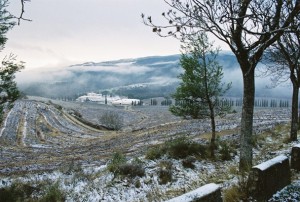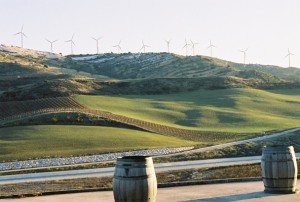A surprise trip to Navarra gave me the opportunity to plan a pilgrimage to Santago de Compostelle and also to discover the region’s innovative wineries.
Terraces had been cut into the vineyard breaking the slope as it fell away down to the bodegas a couple of hundred feet below. The old bush vines, twisted and gnarled, looked surreal and other-worldly covered with a dusting of snow. The little chapel surrounded by conifers seemed to promise generations of stories: births, marriages and deaths, no doubt some heroes but probably some fools too, best forgotten.
So how come I came to be here? Why was I standing in the vineyard at Bodegas de Sarría in Navarra, Northern Spain two weeks before Christmas? I was supposed to be sitting in front of my computer in grey London. The trip was so unexpected and exciting it felt a bit like falling through a wardrobe and ending up in a wintery Narnia.
I’d had a ‘phone call out of the blue a couple of weeks earlier. ‘Would you be interested in going to Navarra on a press trip for wine writers?’ Usually I’d have said no as I believe it pays to specialise and France is my particular area of interest. Plus I don’t have the bare-faced cheek to accept press trips to places I won’t be writing about just for a free holiday.
But Navarra interests me because the Camino de Santaigo or Way of St James, the ancient pilgrimage route to Sanitago de Compostelle, passes through its vineyards. I’ve had a yearning to walk this route for a while now and this trip would give me the perfect opportunity to check out the lie of the land.

I could also learn more about the wines of Navarra which I had to admit I didn’t have a very clear grasp of. Yet perhaps that confusion is inevitable, unlike neighbouring Rioja, one of the world’s benchmark reds, Navarra doesn’t have one defining style. It uses the word ‘diversity’ in its marketing, which is always something of a rough school for disparate souls, yet it is probably apt for Navarra. Once the region specialised in rosés (perfect for pilgrims!) but nowadays the reds are by far the most interesting. (See below for a few that I particularly enjoyed.)
What is also striking is the modernity of many of the wineries. It is easy to assume that a region which is crossed by a pilgrim’s path which has been in use for a millennia is going to be retrospective, but Navarra is far from that. Perhaps because it isn’t a well know wine region it can’t rest on its laurels knowing that customers in restaurants all over the world will simply say ‘Navarra’ in the way they say ‘Rioja’.
Some wineries are overwhelming in size, like Bodegas Principe de Viana which looks after over 1,000 ha of land. Here they have their own cooperage and are experimenting with woods from Eastern Europe as well as the usual French and American oak. Others are more human sized like Tandem with just 22ha and a state of the art viticultural kit, including innovative stainless steel fermentation tanks combined with concrete maturation tanks all housed in an energy efficient winery.
Then there’s Bodegas Inurrieta which has had secret plantings of Sauvignon Blanc, Syrah and Petit Verdot. Sauvignon Blanc and Syrah have now be authorised. Bodegas Nekeas also has experimental Viognier but are less than convinced by the results. No matter their Grenache is sublime.
A couple of wineries are also making Pago wines, (namely Bodegas Irache with Pago Irache and Gran Vino de Pago de Arínzoa from Chivite). This is a new classification which is supposedly recognising exceptional wines. However as many of the best Spanish wines, Vega de Sicilia being the obvious example, are not Pago then the system seems flawed. Equally as it does not take into account DOCa in Rioja, the top tier of that region, then it is hard to see this as more than a marketing exercise. I also wondered if a new classification will be of much use to consumers. When I work at wine shows people tend to want simplification, so they can easily understand what they are buying, rather than yet more classifications to get to grips with. These wines may be estimable (Gran Vino de Pago de Arínzono 2001 is particularly good) but I’m afraid I’ve missed the point of Pago. Still it shows a willingness to innovate.
So at the end of the trip as I stood in the biting wind on the Pilgrim’s Bridge in Puenta la Reina I looked back at the few days I’d spent in Navarra. The fact that the wineries are experimenting and innovative was particularly inspiring. After all when I walk the pilgrims’ path I do not want to visit another world, a Narnia. I may be looking forward to seeing the historical sites along the route but I also want to see contemporary and vital Spain. Just as I do not want the pilgrimage experience to happen in a vacuum, I want it to be more meaningful. High hopes perhaps, but no one plans a pilgrimage unless they dare to dream.
My thanks to Wines of Navarra for inviting me to visit their vineyards. Here are are some of my favourite wines:

Bodegas Nekeas, El Chaparral, Old Vine Grenache, 2007. Concha Vecino, the softy spoken winemaker at Nekeas believes that this patch of old vine Garnacha is the original Northern Spanish variety. It is certainly a superior Grenache wine with a great smelling sweet nose, with plenty of red fruit, a touch of spiciness and milk chocolate flavours.
Bodegas Sarría, Senorra de Sarría, Graciano and Merlot, 2006. This is an unoaked wine which smells and tastes of blackberries. My fellow traveller Patricia Langton described it as smelling of ‘freshly made jam’. Yet as all this fruitiness is balanced with crisp acidity it makes a particularly pleasing glassful.
Bodegas Orvalaiz, Septentrion, Tempranillo and Cabernet Sauvignon, 2005. This winery blatantly uses its proximity to the Way of St James as part of its marketing. As some 45,000 pilgrims passed their way in 2007 I guess they’d be foolish not to. This wine has a good structure with chewy tannins and good black fruit but at three years old, with 14 months in new French oak this wine is still a baby.
Bodegas Inurrieta, Sur, Grenache, Shiraz and Merlot, 2005. Shiraz has only recently been authorised in Navarra but this group of mavericks at Inurrieta have been growing it for a few years. The wine has a meaty, savoury palate with a pleasing violet note. It is warm, full-flavoured and chewy. It goes particularly well with the delicious cordero al chilindron or lamb casserole that the brothers who own this outfit cooked us for lunch.
Tandem, Ars Mácula, Cabernet Sauvignon and Merlot, 2004. This is a very grown-up wine with a powerful and leathery nose with a spicy, Christmas cake backnote. The palate is intense and oaky with good blackcurrant and tobacco notes. At 15° this is very high in alcohol although this is not particularly evident on the palate. (It would still give you a banging hang-over though even if it is well disguised.)
Chivite Colección 125 Reserva, Tempranillo, Merlot and Cabernet Sauvignon, 2004. This rich red has lots of wood and cherry notes on the nose and palate. It is matched by a smoky oak note, very juicy fruit and attractive with chewy tannins. This is still tastes very young and has plenty of potential to evolve into something more integrated and complex.
Flor de Lasierpe Reserva, Cabernet Sauvignon, Tempranillo, Merlot and Graciano, 2000. It always pleases my socialist heart to find a great wine from a cooperative. This mature wine has an attractive perfume with notes of beeswax, coffee and red fruits. The palate also has notes of coffee plus chocolate, pepper balanced with fine tannins and a very long finish.
